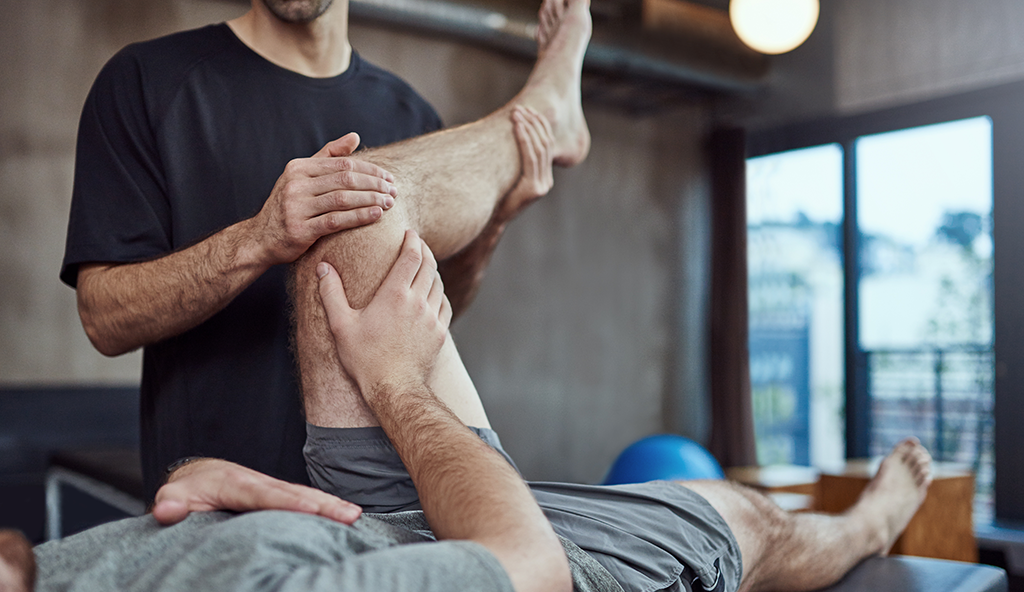Injury Overview
ACL knee injuries are among the most common injuries for athletes. The ACL (anterior cruciate ligament) is one of four ligaments that make up the knee joint and is responsible for keeping the shinbone (tibia) from sliding forward on the thigh bone (femur) and providing stability for movements requiring rotation of the knee. Cutting and pivoting athletes, including soccer players, football players, basketball players, and skiers, are at a higher risk for developing an ACL knee injury because of the sudden pivots, twists, and turns associated with these sports. The ACL can also be torn in cases that do not involve sports, such as tripping, missing a step, or any other traumatic hit to the knee. Typically, the knee sustains a “pivot shift” event where the bones of the knee shift in an abnormal way.
Symptoms
Patients who have an ACL injury are typically present after a twisting injury event. If during a practice or competition, athletes typically report that they could not continue to perform/compete during that day and that the knee swelled immediately after the injury. Swelling inside the knee from the injury routinely causes it to swell to the size of a softball. Sometimes, athletes report the sound of one or more pops.
After a few days, the swelling improves and the function returns. After an ACL injury, recurrent feelings of “giving away” or instability of the knee are common. These episodes can be problematic because continued pivot shifting events can be associated with further injury to the knee, including injuries to the medial meniscus. The knee can shift with certain movements such as pivoting to open a door or cutting with an attempt to return to sport.
Diagnosis
Listening carefully to the athlete’s history of injury is always the most important first step to knowing the problem. Examining the patient thoroughly is the second step, and the Lachman test, anterior drawer test, and pivot shift test are ways to test the ACL for injury. These tests are not painful; however, it is understandable to be apprehensive of tests of knee stability. X-rays are important to see the bone anatomy of an injured athlete, as overall alignment affects the forces on ligaments and knees, and to rule out fractures. MRI is an additional necessary test when an ACL is expected in order to confirm the diagnosis and look for associated injuries, as in many instances the lateral meniscus is injured at the time of an ACL injury.
Treatment
Nonoperative Treatment
Depending on the patient’s lifestyle and goals, the ultimate objective is to return the patient to their pre-injury activities. This involves an individualized treatment plan to regain stability and full mobility of the knee. In some cases of isolated ACL injury, surgery may not be necessary, depending on a patient’s goals. Conservative treatment consists of rest, ice, elevation, anti-inflammatory medications, and physical therapy to strengthen the muscles around the knee and to improve neuromuscular control around the knee. An ACL brace can also help protect the joint during the rehabilitation process.
Surgical Treatment
In athletes who are returning to cutting and pivoting activities, ACL reconstruction surgery is most often recommended. In some instances, an ACL repair can be considered. During ACL reconstruction surgery a tendon graft of a similar size is used to replace the injured tissue. Reconstruction surgery is performed arthroscopically and involves removing the injured tissue and creating a new ligament with a graft. The graft used during the reconstructive process is most often taken from the patient. The central third of the patellar tendon, the central third of the quadriceps tendon, or two of the four hamstring tendons are the most commonly used grafts. Although donated tissue using a graft bank from a donor can also be used, it has been associated with a higher reinjury rate in some studies. Graft choice is individually decided with the patient.
Post Operative
After a reconstruction surgery, a thorough physical therapy program is extremely important for rehabilitation. Rehabilitation will be a progressive process that may initially limit movement. The first phases focus on swelling and the return of normal knee motion. Further phases focus on regaining strength, balance, and functional movement patterns.
Recovery Time
After an ACL reconstruction, cutting and pivoting activities are limited until around the 7 month time point as graft maturation takes time. Two studies on reinjury rates suggest that risk decreases significantly with every month until the 9-month time point.1,2
For this reason, in most instances a return to cutting/pivoting sports is cautioned before the 9-month milestone. However, every athlete is unique and situations are unique. Some instances dictate a sooner return to sport than 9-months understanding the risk. Post-operative rehabilitation and returning to sport is a joint effort/decision between the patient, Dr. Anz, the physical therapist, and the athletic trainer and is necessary to achieve the most optimal outcome.
Athletes with ACL injuries should not feel bad if it takes time to return to their sport. In many instances it takes athletes one to two years to make a full return. A study in high-school and college football players found a return to sport rate of 32% at one year and 64% at two years. 53% of high school players and 50% of collegiate players identified fear as a major or contributing factor to not returning to play sooner.3 Dr. Anz and his team serve as advocates to help athletes return safely and expeditiously to their sport, considering and helping with all hurdles along the way.
References:
- https://www.ncbi.nlm.nih.gov/pmc/articles/PMC4912389/pdf/nihms782171.pdf
- https://www.jospt.org/doi/full/10.2519/jospt.2020.9071
- https://pubmed.ncbi.nlm.nih.gov/22922520/
—
For additional information on ACL knee injuries, or to learn more about what is involved during ACL reconstruction surgery, please contact the office of orthopedic knee surgeon, Dr. Adam Anz, serving the greater Pensacola, Gulf Breeze, Florida communities.




